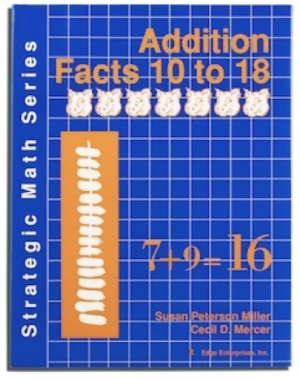Strategic Math: Addition Facts 10 to 18

The Strategic Math Series focuses on how to teach basic math facts and operations to students of any age. Content is built upon the concrete-representational-abstract method of instruction. In this approach, understanding of mathematics is developed through the use of concrete objects, representational drawings, and an easy-to-learn strategy that turns all students into active problem solvers.
Addition Facts 10 to 18 provides the materials you need to teach addition facts using the concrete-representational-abstract method of instruction, including specific teaching procedures and student materials for each lesson.
In studies, students who scored below mastery on a computation pretest and word problem pretest increased their computation scores from a pretest mean of 49 percent to a posttest mean of 93 percent. The word problem performance of these students rose from a pretest mean of 42 percent to a posttest mean of 87 percent. A second group of students who scored 80 percent or higher on the computation pretest but below mastery on the word problem pretest increased their word problem scores from a pretest mean of 41 percent to a posttest mean of 91 percent.
Author(s):Susan Peterson Miller, Cecil D. Mercer
Publication and Purchasing Information: University of Kansas, Center for Research on Learning / KU CRL Online Store
Resources:
Research: Addition Facts 10 to 18 (.pdf)
Research Articles:
- Miller, S. P., & Mercer, C. D. (1993). Using data to learn concrete-semiconcrete-abstract instruction for students with math disabilities. Learning Disabilities Research & Practice. https://psycnet.apa.org/record/1994-23423-001
- Miller, S., & Strawser, S. (1996). Promoting strategic math performance among students with learning disabilities. Learning Disability Forum, 21(2), 34-40. This article provides suggestions for classroom teachers who want to integrate strategy instruction into their math curriculum by discussing a strategic classroom environment and strategic learners.
This product is available through the KUCRL Shop
Please note that professional development, coaching, and infrastructure support are essential components to effective implementation of SIM instructional tools and interventions. It is highly recommended that you work with a SIM professional developer. See the SIM Event list for sessions or email simpd@ku.edu to learn more.
More in the Strategic Math Series
An accessible version of the documents on this site will be made available upon request. Please contact the KU CRL Professional Development Research Institute, at simpd@ku.edu to request the document be made available in an accessible format.